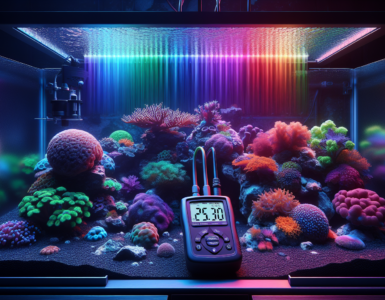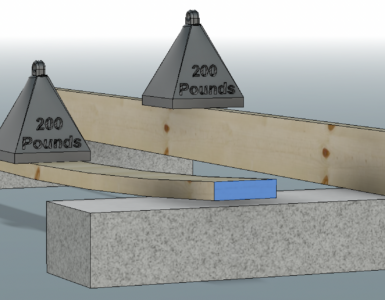The physics of water flow
Many aquarists manage their tanks without understanding the physics of water flow. However, a basic knowledge of how water moves through your aquarium’s plumbing can help you design a more efficient and reliable system. One of the most common questions is:
How much water flows?
One of the most common questions is “How much water will flow through a bulkhead?”. To answer this, we use fundamental principles from fluid dynamics, specifically Bernoulli’s equation and considerations of friction losses in pipes.
Bernoulli’s Equation
Bernoulli’s principle allows us to calculate the velocity \( v \) of water flowing through an opening under the influence of gravity:
\( v = \sqrt{2 g H} \)
- \( v \): Velocity of water (meters per second, m/s)
- \( g \): Acceleration due to gravity (9.81 m/s²)
- \( H \): Height of water above the opening (meters, m)
This equation assumes that water behaves like any object falling under gravity, gaining speed as it drops.
Calculating Flow Rate
Once we have the velocity, we can determine the flow rate \( Q \) using:
\( Q = C_d \times A \times v \)
- \( Q \): Flow rate (cubic meters per second, m³/s)
- \( C_d \): Discharge coefficient (dimensionless)
- \( A \): Cross-sectional area of the bulkhead or pipe (square meters, m²)
Cross-Sectional Area Calculation:
\( A = \pi \times \left( \frac{D}{2} \right)^2 \)
- \( D \): Internal diameter of the bulkhead or pipe (meters, m)
Discharge Coefficient \( C_d \)
The discharge coefficient accounts for energy losses due to the shape of the opening and flow conditions:
\( C_d \approx 0.62\) for sharp-edged orifices for short pipes wheres\(\frac{L}{D} < 3 \)
\( C_d \approx 0.81 \) for longer pipes \(\frac{L}{D} \geq 3 \)
The ratio of the pipe’s length \( L \) to its diameter \( D \) determines which \( C_d \) value to use.
Including Friction and Minor Losses
In setups where water flows through pipes (such as siphons), friction and minor losses affect the flow rate.
Total Head Losses:
\( H_{\text{loss}} = f \left( \frac{L}{D} \right) \frac{v^2}{2g} + K_{\text{in}} \frac{v^2}{2g} + K_{\text{out}} \frac{v^2}{2g} \)
- \( H_{\text{loss}} \): Total head loss (meters, m)
- \( f \): Friction factor (dimensionless, typically around 0.02 for smooth pipes)
- \( L \): Total length of the pipe (meters, m)
- \( K_{\text{in}} \), \( K_{\text{out}} \): Entrance and exit loss coefficients (dimensionless)
These losses reduce the effective head driving the flow and must be considered for accurate calculations.
Using the Tank Discharge Calculator
I have developed a calculator to help you estimate the flow rate based on your specific setup. It considers:
- Pipe Lengths and Diameters: Input lengths and internal diameters for both inlet and outlet pipes.
- Head Heights: Enter the vertical distances relevant to your system.
- Discharge Coefficient \( C_d \): Automatically calculated based on your pipe’s \( \frac{L}{D} \) ratio.
- Friction and Minor Losses: Accounted for in siphon systems to provide a realistic flow rate.
Note: The calculator assumes that the flow is single-phase (water only) without air entrainment. Introducing air can significantly alter flow characteristics.
Example Usage
Suppose you have:
- Bulkhead Diameter \( D \): 1.033 inches (0.02624 meters)
- Inlet Pipe Length Inside Tank \( L_1 \): 12 inches (0.3048 meters)
- Discharge Pipe Length \( L_2 \): 24 inches (0.6096 meters)
- Head Height \( H \): 24 inches (0.6096 meters)
Steps:
- Calculate \( \frac{L}{D} \) Ratios:
- Inlet Pipe \( \frac{L_1}{D} \): \( \frac{L_1}{D} = \frac{0.3048}{0.02624} \approx 11.61 \)
Since \( \frac{L_1}{D} \geq 3 \), use \( C_d = 0.81 \).
- Inlet Pipe \( \frac{L_1}{D} \): \( \frac{L_1}{D} = \frac{0.3048}{0.02624} \approx 11.61 \)
- Compute Cross-Sectional Area \( A\): \( A = \pi \times \left( \frac{0.02624}{2} \right)^2 \approx 0.0005405 \text{ m}^2 \)
- Calculate Velocity \( v \): \( v = \sqrt{2 \times 9.81 \times 0.6096} \approx 3.454 \text{ m/s} \)
- Determine Flow Rate \( Q \): \( Q = 0.81 \times 0.0005405 \times 3.454 \approx 0.00151 \text{ m}^3/\text{s} \)
- Account for Friction and Minor Losses:
- Total Pipe Length \( L = L_1 + L_2 \): \( L = 0.3048 + 0.6096 = 0.9144 \text{ m} \)
- Friction Factor \( f \): Assume \( f = 0.02 \)
- Entrance Loss Coefficient \( K_{\text{in}} \): \( K_{\text{in}} = 0.04 \) (since \( \frac{L_1}{D} \geq 3 )\)
- Exit Loss Coefficient \( K_{\text{out}} \): \( K_{\text{out}} = 1.0 \) (for submerged discharge)
- Total Head Loss Coefficient \( K_{\text{total}} \): \( K_{\text{total}} = f \left( \frac{L}{D} \right) + K_{\text{in}} + K_{\text{out}} = 0.02 \left( \frac{0.9144}{0.02624} \right) + 0.04 + 1.0 \approx 1.74 \)
- Adjusted Velocity \( v_{\text{adj}} \): \( v_{\text{adj}} = \sqrt{ \frac{2 \times 9.81 \times 0.6096}{1.74} } \approx 2.622 \text{ m/s} \)
- Adjusted Flow Rate \( Q_{\text{adj}} \): \( Q_{\text{adj}} = 0.81 \times 0.0005405 \times 2.622 \approx 0.00115 \text{ m}^3/\text{s} \)
- Convert Flow Rate to Gallons per Hour (GPH):\( Q_{\text{GPH}} = Q_{\text{adj}} \times 3600 \times 264.172 \approx 1,093 \text{ GPH} \)
Result:
The estimated maximum flow rate, considering friction and minor losses, is approximately 1,093 GPH.
Conclusion
By applying these calculations, you can determine how much water will flow through your bulkhead and pipes. This helps in designing an aquarium plumbing system that efficiently handles your desired flow rates, ensuring a healthy environment for your aquatic life.
Note:
Consistent Units: Always convert measurements to consistent units (e.g., meters)




Wish this article still had the calculator.
Maybe one day soon I can build a new version. The old version was FLASH based and no longer supported. I had started to convert to HTML5 but have not had a chance to complete the project.